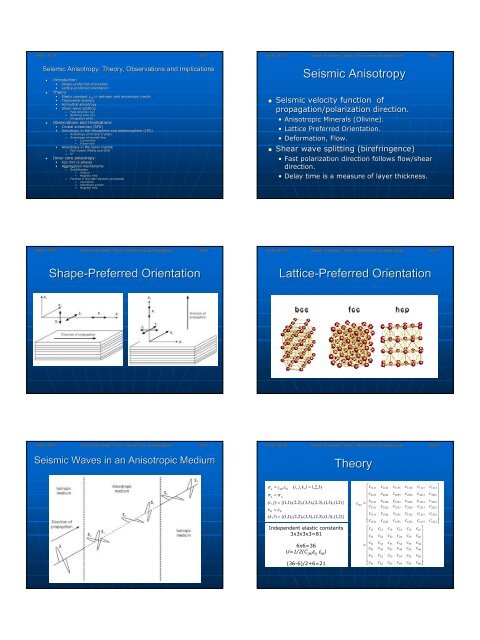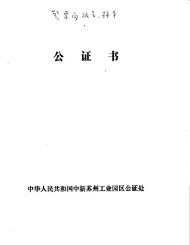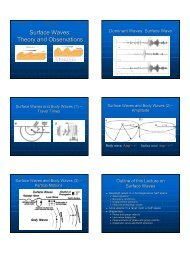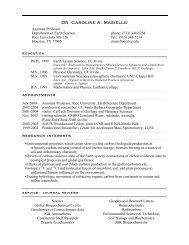Seismic Anisotropy Shape-Preferred Orientation Lattice-Preferred ...
Seismic Anisotropy Shape-Preferred Orientation Lattice-Preferred ...
Seismic Anisotropy Shape-Preferred Orientation Lattice-Preferred ...
- No tags were found...
You also want an ePaper? Increase the reach of your titles
YUMPU automatically turns print PDFs into web optimized ePapers that Google loves.
week 6, 02/18<strong>Seismic</strong> <strong>Anisotropy</strong>: Theory, Observations and ImplicationsTransverse Isotropyslide 7week 6, 02/18<strong>Seismic</strong> <strong>Anisotropy</strong>: Theory, Observations and ImplicationsAzimuthal <strong>Anisotropy</strong>slide 8θc mn⎡ A A − 2NF 0 0⎢A − 2N⎢A F 0 0F F=⎢⎢ 0 0C00L00⎢⎢ 0 0 0 0 L⎣ 0 ⎢ 0 0 0 00 ⎤0⎥⎥0 ⎥0 ⎥⎥0 ⎥N ⎥⎦A NP1= , S1= , S2=ρ ρP2=CρLρP θ ) = A + A cos2θ+ A sin 2θ+ A cos4θ+ sin 4θ(1 234A5week 6, 02/18<strong>Seismic</strong> <strong>Anisotropy</strong>: Theory, Observations and Implicationsslide 9Measurements of <strong>Seismic</strong> <strong>Anisotropy</strong>week 6, 02/18<strong>Seismic</strong> <strong>Anisotropy</strong>: Theory, Observations and Implicationsslide 10Example of Shear-Wave Splittings ( t)= s(t)cosφ,s ( t)= s(t − δt)sinφ,122R(t)= s(t)cosφ + s(t − δt)sinφ,T ( t)= [ s(t)− s(t − δt)]sinφcosφ,2week 6, 02/18<strong>Seismic</strong> <strong>Anisotropy</strong>: Theory, Observations and ImplicationsCrustal <strong>Anisotropy</strong> (SPO)slide 11week 6, 02/18<strong>Seismic</strong> <strong>Anisotropy</strong>: Theory, Observations and Implicationsslide 12<strong>Anisotropy</strong> in the Lithosphere and Asthenosphere(LPO): <strong>Anisotropy</strong> of Olivine Crystals
week 6, 02/18<strong>Seismic</strong> <strong>Anisotropy</strong>: Theory, Observations and Implicationsslide 19 week 6, 02/18<strong>Seismic</strong> <strong>Anisotropy</strong>: Theory, Observations and Implicationsslide 20Inner Core Isotropyweek 6, 02/18<strong>Seismic</strong> <strong>Anisotropy</strong>: Theory, Observations and Implicationsslide 21IC composition and physical state• Composition:• Fe• Light elements• Ni, S, O, Si…,• radiogenic elements?• Physical state:• Crystal structure• body-centered cubic(b.c.c)• face-centered centered cubic(f.c.c)• hexagon closed packet(h.c.p)• Temperature• Elastic properties:• seismic wave velocity• anisotropyFe crystalline formsStixrude and Cohen, 1994week 6, 02/18<strong>Seismic</strong> <strong>Anisotropy</strong>: Theory, Observations and ImplicationsAnisotropic IC Growth• Flow-inducedpreferredorientation• Theory of Kamb‘59• Elastic constantsof Steinle-Neumann et al.• Strongest signalalong rotationaxisslide 22c aSumita & Yoshida, in reviewweek 6, 02/18<strong>Seismic</strong> <strong>Anisotropy</strong>: Theory, Observations and ImplicationsEffects of Magnetic Fieldsslide 23• Karato (Nature(Nature, , 1993)• Argues that anisotropic magnetic susceptibilitywill cause Fe to become aligned as it freezes atthe ICB• Karato (Nature(Nature, , 1999)• Argues that Maxwell stresses will align Fe xtals.• Relies on magnetic pressure perturbation fromIC toroidal B• How strong is B T ?• IC density stratification?• Buffett and Wenk (Nature(413: : 60- 63,2001)• How strong is B T ?• What is the IC viscosity?









